An edited version of this article was published for Red Pepper as Brazil: The Giant has Awoken
I’ll try and keep this short cause I’ve hardly slept and have an English class to prepare. (I’m interested to know what my students in Tuiuti favela will make of it all!) Besides, I’ve discussed in detail what I think are the underlying local causes of the protest in another post.
Last night’s scenes in Rio were incredible and exhilarating. At times they shocking. I started with a ‘bloco’ (a music band leading a large crowd of people, as is often seen at carnival) at the Largo São Francisco de Paula, a square in the central shopping district of Uruguaiana. The crowd mainly consisted of university students from the Federal University. The mood was jovial. A standard read “Nada deve parecer impossível de mudar” (“Nothing should seem impossible to change”), a quote by Berthold Brecht.
A speaker shouted out instructions for the route the crowd would take towards the Candelaria Church and exhorted his audience to be disciplined, peaceful and brave in the event of confrontation with police. The crowd collectively repeated the words so that those at the back could hear – a technique developed by trade unions and democracy activists during the 1980s. Everyone sang “Olê olê, olê olá, se a passagem não abaixar, o Rio, o Rio, o Rio vai parar!”, roughly translated as “If the (bus) fare is not reduced, we will bring Rio to a halt!”. This refers to the recent price hike that inspired last week’s initial protests in São Paulo.
The crowd began to move and upon reaching the Avenida Getúlio Vargas converged with a much larger protest (estimates of up to 100,000) making its way towards the Candelaria. I think here everyone began to realise the scale and importance of what was going on. Placards and banners with messages like “O gigante acordou” (“The giant has awoken”), “Saimos do Facebook” (We’ve come off Facebook”), and “Somos a rede social” (“We are the social network”) betrayed a mixture of joy and relief. In a country often seen as politically passive, a silent majority was finding its voice. The marchers gleefully chanted “Não é Turquía, não é Grécia, é o Brazil saindo da inércia” (“It’s not Turkey, it’s not Greece, it’s Brazil leaving its inertia”).
The participants were predominantly young – I would estimate the average age as 20-25. But make no mistake, this is a broad-based movement. Suited professional leaving their workplaces mixed in with the crowds. Office workers waved white sheets and threw confetti from the skyscrapers overlooking the procession, as the marchers invited them to join them in the street.
Similarly there was a dominant middle-class presence, but also many who were clearly from humbler backgrounds. In my everyday interactions and in my research I have found people of every age and across the social spectrum voicing the same grievances: a corrupt and arrogant political elite, high costs, substandard public services and a contemptuous attitude towards human rights, particularly by the police. Until now they discussed these problems with resignation, assuming that ‘that’s just the way Brazil is’. Now they are demanding change.
In Rio the protests have been targeted at the State Governor Sergio Cabral, who chanters accused of being a dictator, and Mayor Eduardo Paes, who they frequently invited to “go fuck himself”. Placards criticising favela removal and pacification policies associated with these two men could also be seen, and the image below shows them holding Rio’s famous Christ statue hostage. Brazil’s highly federalised system leaves significant powers at the state and municipal levels, including in the key areas of health, education, policing and transport. As a result President Dilma Rousseff has been less a target of the protests. However many believe she has not used her powers to pressure for change. One banner called for Dilma to ‘wake up’, as Brazil had, implicitly referring to her own revolutionary past. Wider disillusionment with her Workers Party, the PT, was expressed by the chant “Não temos partido” (“We have no party”).
One central component of the protests which I refer to in my other post, is the World Cup and, in the case of Rio, the Olympics. These mega-events were promised as catalysts for social change, but instead are seen as lining the pockets of speculators, (inept) construction firms and their political sponsors. Meanwhile public services have been left to rot. Innumerable placards and chants highlighted this contrast. For example: “Quantas escolas cabem na Maracanã?” (“How many schools fit in the Maracanã?”) and “Copa do Mundo eu abro mão, quero dinheiro pra saúde e educação” (“Forget the World Cup, I want money for health and education”). One sign ominously read “There will be no world cup”. This will send shivers down the spines of political elites who see the successful hosting of the events as economically and symbolically crucial for the future of the country, and for their own reputations. They may have been concerned about drugs gangs and street criminals marring the events, but they never foresaw the possibility of mass opposition. (Popular protest is something Brazilian elites are typically unconcerned about).
After reaching the Candelaria the protesters continued on towards Cinelândia. The crowd had separated slightly and many congregated on the steps of the beautiful Theatro Municipal awaiting the main body. The mood was still light-hearted. Occasional loud bangs (I’m not sure what these were, as they were not caused by police or protestors) prompted chants of “Sem violência” (“No violence”). There was a conspicuous lack of police presence, except for two low-flying helicopters which accompanied the protest throughout. This was presumably a deliberate strategy following the outrage they provoked with their indiscriminate use of pepper spray and rubber bullets in São Paulo.
When the march finally converged upon the ALERJ, the Rio state legislative assembly, the picture began to change somewhat. Perhaps around 30 police guards were stationed outside, behind a wall of railings. As the mass arrived some elements began to throw bottle and stones, thinning out the police line and pushing them up the steps towards the entrance of the building. Crackling fireworks that were being set off into the air began to be directed towards the building. Then what appeared to be a molotov cocktail started a fire beneath the building’s main columns, causing the remaining police, by now at the top of the stairs, to scramble into the building. The crowd broke through the gates and occupied the steps. (A video I took of the incident is available here). Fires were started in the square and surrounding streets including a particularly large one that I later found out was a burning car.
For the next two hours police attempted to clear the square using tear gas. I was never close enough to see how many there were or which direction they were coming from. Protestors would flee down side streets, only to return as the air cleared. I saw a few people spitting blood. This pattern continued for at least the next two hours. It was only at this stage that I saw any vandalism – mainly masked, adrenaline-fuelled teenagers smashing windows and graffitiing on walls. (The main target of the window breaking seemed to be Itaú bank – I’m not sure if this is because they have done something in particular to offend the protesters, or simply that they were the only ones who had no grilles over their windows). In almost every case other protestors intervened to try and stop the vandalism, usually successfully. In one case a very large crowd chanted “sem vandalismo” (“no vandalism”) at a young man trying to kick in a window, and he sheepishly walked away.
I headed home around 9.30pm when there were still several thousand protesters in the square. There have been reports of disproportionate police violence at this stage, though I personally did not witness any apart from the continuous use of tear gas. The firebombing of the ALERJ was certainly a shocking sight, but it only takes a few individuals to do something like that. The vast majority of the protest was remarkably peaceful – and self-policing. A few days ago the violence might have been used to sway public opinion against the protests, but I suspect after the earlier actions of the police elsewhere and the momentum the movement has taken on it is too late for that. Further protests are scheduled for later this week in Rio and other cities.
O Brasil Acordou! Brazil has awoken!
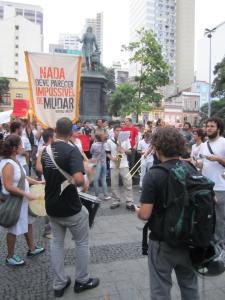
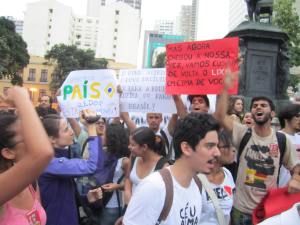
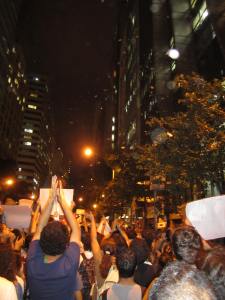
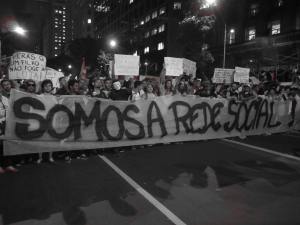
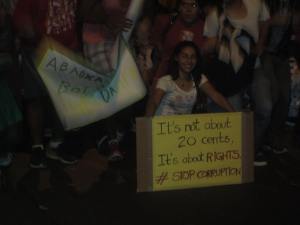
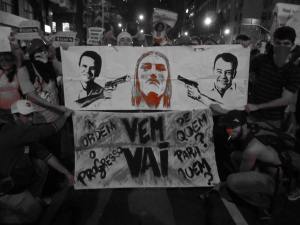
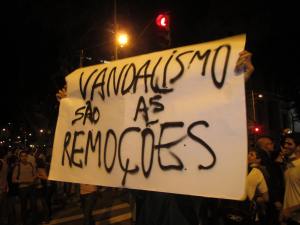
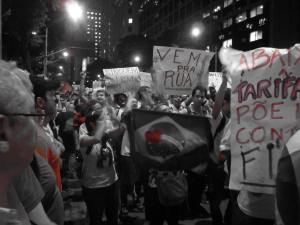
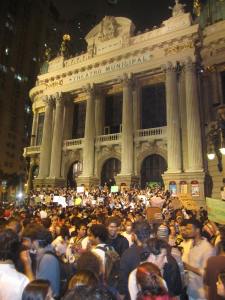
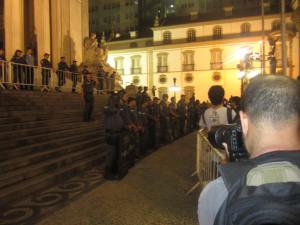
You say:
” It was only at this stage that I saw any vandalism – mainly masked, adrenaline-fuelled teenagers smashing windows and graffitiing on walls. (The main target of the window breaking seemed to be Itaú bank – I’m not sure if this is because they have done something in particular to offend the protesters, or simply that they were the only ones who had no grilles over their windows). In almost every case other protestors intervened to try and stop the vandalism, usually successfully. In one case a very large crowd chanted “sem vandalismo” (“no vandalism”) at a young man trying to kick in a window, and he sheepishly walked away.”
Nothing wrong with a bit of internationalist vandalism – particularly against banks. There’s virtually nothing in the way this world is organised which is worth preserving in its present form. Smashing things up is a perfectly valid expression of anger against a world which reduces humans to things and elevates things to untouchable idols. The Situationists wrote, in their analysis of the uprising in Watts almost 40 years ago, ” once the vaunted abundance is taken at face value and directly seized, instead of being eternally pursued in the rat-race of alienated labor and increasing unmet social needs, real desires begin to be expressed in festive celebration, in playful self-assertion, in the potlatch of destruction. People who destroy commodities show their human superiority over commodities. They stop submitting to the arbitrary forms that distortedly reflect their real needs.”
We need more vandalism – and more coherent vandalism:
“The alienation of the proletarian consists in this: his work has substance but no freedom; his leisure has freedom but no substance. What he does of consequence is not his, and what he does that is his has no consequences; nothing is at stake in his play….
It is this social schizophrenia, this desperately felt need to see their own action, to do something that is really theirs, which causes masses of people to take up crafts or vandalism; and still others to try and suppress the split by attacking the separation in a unified way, by taking up coherent vandalism: the craft of the negative.”